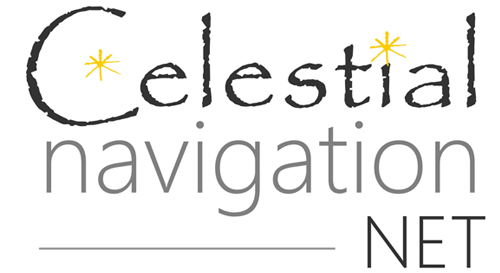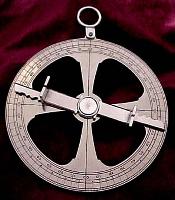Navigational Instruments
The main instruments mariners need for Celestial Navigation are the chronometer and some way of measuring the altitude of bodies above the horizon. There are good pictures and history of the former at John Harrison and the Longitude Problem. The latter can be as simple as your hand span, a ruler, or a couple of pencils lashed together or as sophisticated as a modern double-reflecting sextant, which measures in seconds of arc. The Classroom page has links to projects for making some of these instruments, and the book Latitude Hooks and Azimuth Rings by Dennis Fisher has instructions for all of them. Celestaire sells gold-colored cardboard kits for making a working nocturnal (along with a sundial and perpetual calendar) and mariner’s astrolabe.
THE book to own is Peter Ifland’s beautiful and thorough Taking the Stars: Celestial Navigation from Argonauts to Astronauts. His lecture (see under Sextants, below) has many beautiful pictures of different instruments.
And THE place to go for historical pictures and information is “Scientific Instruments of Medieval and Renaissance Europe.”
**NEW!DON’T MISS OMAR REIS’S INTERACTIVE SEXTANTONLINE!
He also has a “Build Your Own Sextant” page. Celestaire sells the cardboard sextant kit.
LATITUDE HOOK, KAMAL
These are among the simplest methods of measuring altitude. The latitude hook of the Polynesians was a piece of split bamboo with a loop at the top; its length was aligned with the horizon and star to show when the desired latitude had been reached.
The Arabs used a more refined tool called the kamal, a rectangle of wood cut to fit the distance from the horizon to the star. It had a piece of knotted string attached, which could be held in the teeth, guaranteeing that an “arm’s length” distance would remain uniform. The photo is from Peter Ifland’s site – click on it.
CROSS-STAFF AND BACKSTAFF
The cross-staff measures up from the horizon to the body rather than down from the zenith, since the horizon is a clear and definite line (well, on good days!). This was an advance over zenith devices and could be done by one person. A wooden staff is placed on the cheek and a crossbar is slid along its length until it fits between the body and the horizon. The backstaff was invented in 1590 by John Davis (see his Seaman’s Secrets), and allowed the navigator to stand with his back to the sun, working with its shadow.
QUADRANT
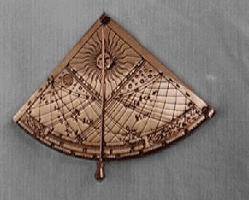
This instrument, shaped like a quarter of a circle, measured the angle from the vertical – not horizontal – and the line of sight to the body. It was suspended from a ring and had a weighted line hanging down, which crossed one of the angle numbers marked on the ring. Columbus used one, but after trying it, it’s hard to imagine how it was held stable!
ASTROLABE
The first part of its name comes from the same Greek word that gave us “astronomy” – aster, or star – and the second derives from a Greek word meaning take, grasp, or determine. So the name can be translated as “star-finder” or “star-taker.” The astrolabe is an instrument that provides a picture of how the sky looks at the observer’s latitude and time. It has moveable parts that allow it to be set for specific dates and times, and interchangeable templates that allow latitude to be set. Besides showing the position of the sun and stars, the astrolabe can measured the altitude of the body, and the Mariner’s Astrolabe eliminated all the parts that weren’t necessary for this use. Like the quadrant, it had to be held vertical so that the zenith distance (degrees down from the point over the observer’s head to the body) could be measured. Subtracted from 90 degrees, this gives the altitude, and for the Pole Star, this was an approximation of the observer’s latitude. A modern version is the 2102-D Star-Finder – See Practice. The photos are by Norman Greene – click on them for his website.
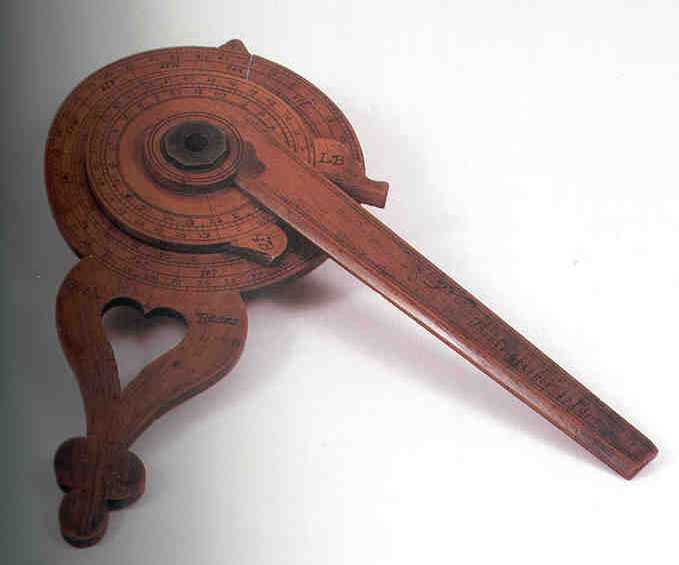
NOCTURNAL
The nocturnal was used to tell time by the celestial clock. One ring was set to the date, Polaris was sighted through the hole in the center, and the arm was swung around to align with pointer stars – those in the Big Dipper, Little Dipper, or Cassiopeia. Where the arm crossed the marked ring, the time was read.
It was also used to measure Polaris’s distance in minutes of arc from true north so a correction could be applied.
Here are good sites for the instruments named above:
- Richard A. Paselk has an excellent site on Medieval Scientific Instruments which shouldn’t be missed, especially the pages for the kamal, cross-staff, and quadrant. There are instructions for making and using them. He also has some of the best pictures on the Internet of the Mariner’s Astrolabe and Planispheric Astrolabe.
- Hands-On Astrolabe Page, with history. You can download templates for your latitude to make your own astrolabe.
- Chaucer’s Treatise on the Astrolabe
THE SEXTANT
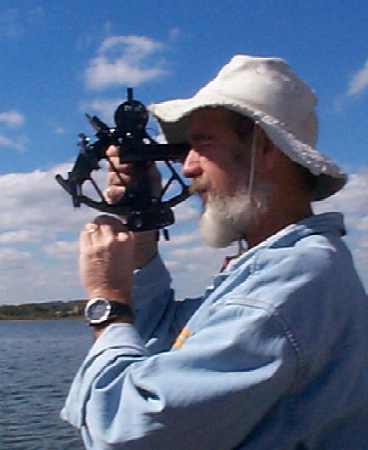
The double-reflecting instrument (one that uses two mirrors to bring the celestial body down to the horizon; hence the navigator no longer has to try to look two places at once) was apparently invented by Newton in 1699, though it was London mathematician John Hadley who got the credit for first producing one in 1731. To complicate matters, American inventor Thomas Godfrey built one in 1730, but was not acknowledged by the Royal Society. Hadley’s second instrument had an arc of 1/8 of a circle and hence was called an octant; the sextant is 1/6 of a circle. Here is Bruce Bauer’s definition: “A sextant is, in essence, a machine for varying the angle between two mirrors by precisely measurable numbers of degrees to utilize the phenomenon that the angle of the departing light ray will have been changed by double the angle between the mirrors.” Bauer’s The Sextant Book (International Marine, Camden, 1992), is the bible for this instrument, and covers adjustment, repair, use, and history.
PBS has a page on How a Sextant Works as well as Navigation By Sextant.
How to Use Plastic Sextants: With Applications to Metal Sextants and a Review of Sextant Piloting – David Burch of Starpath covers every single thing a beginner needs to know – even if you have a metal sextant!
HIGHLY RECOMMENDED: Peter Ifland’s lecture, THE HISTORY OF THE SEXTANT, delivered in Portugal in October 2000. There are some absolutely beautiful pictures on this site.
See Products on the Resources page for some places to buy sextants. A plastic model is available for about $30.
